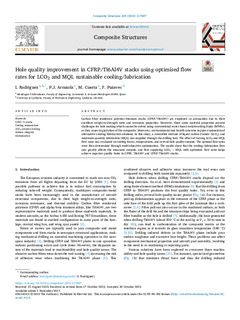
Title
Hole quality improvement in CFRP/Ti6Al4V stacks using optimised flow rates for LCO2 and MQL sustainable cooling/lubricationAuthor (from another institution)
Publication Date
2024Other institutions
University of LjubljanaVersion
Published versionDocument type
Journal ArticleJournal ArticleLanguage
EnglishRights
© 2024 The AuthorsAccess
Open accessPublisher’s version
https://doi.org/10.1016/j.compstruct.2023.117687Published at
Composite Structures Publisher
ElsevierKeywords
CFRP/Ti stacks
Cutting temperature
LCO2 assisted drilling
Surface integrity ... [+]
Cutting temperature
LCO2 assisted drilling
Surface integrity ... [+]
CFRP/Ti stacks
Cutting temperature
LCO2 assisted drilling
Surface integrity
Optimisation [-]
Cutting temperature
LCO2 assisted drilling
Surface integrity
Optimisation [-]
Field (UNESCO Classification)
Technological SciencesDiscipline (UNESCO Classification)
Mechanical technology and engineeringAbstract
Carbon fibre reinforced polymer/titanium stacks (CFRP/Ti6Al4V) are employed in aeronautics due to their excellent weight-to-strength ratio and corrosion properties. However, these same material proper ... [+]
Carbon fibre reinforced polymer/titanium stacks (CFRP/Ti6Al4V) are employed in aeronautics due to their excellent weight-to-strength ratio and corrosion properties. However, these same material properties present challenges for hole making which cannot be solved using conventional water-based metalworking fluids (MWFs), as they cause degradation of the composite. Moreover, environmental and health concerns require exploration of alternative cooling/lubrication solutions. In this study, a controlled mixture of liquid carbon dioxide (LCO2) and minimum quantity lubrication (MQL) was supplied through the drilling tool. The effect of varying LCO2 and MQL flow rates was evaluated on cutting forces, temperatures, and several hole quality outputs. The optimal flow rates were then determined through multi-objective optimisation. The results show that the cooling/lubrication flow rate greatly affects the measured outputs, and that supplying LCO2 + MQL with optimised flow rates helps achieve superior quality holes in CFRP, Ti6Al4V and CFRP/Ti6Al4V stacks. [-]
Collections
- Articles - Engineering [758]
The following license files are associated with this item:




















